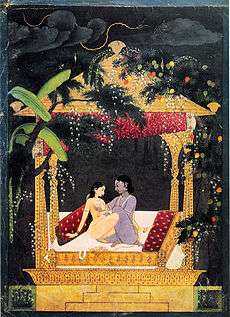Krishna and Radha in a Pavilion
Krishna and Radha in a Pavilion is an 18th-century Indian painting depicting the two Hindu deities Krishna and Radha engaged in sexual intercourse.
| Krishna and Radha in a Pavilion | |
|---|---|
 | |
| Artist | Unknown artist |
| Year | circa 1760 |
| Type | Opaque watercolor on paper |
| Dimensions | 28 cm × 20 cm (11 in × 7.9 in) |
| Location | National Museum, New Delhi |
Description
The painting is the example of Pahari painting used in Gardner's Art Through the Ages:[1]
"In Krishna and Radha in a Pavilion, the lovers sit on a bed beneath a jeweled pavilion in a lush garden of ripe mangoes and flowering shrubs. Krishna gazes directly into Radha's face. Radha shyly averts her gaze. It is night, the time of trysts, and the dark monsoon sky momentarily lights up with a lightning flash indicating the moment's electric passion. Lightning is a standard symbol used in Rajput and Pahari miniatures to symbolize spiritual bliss and excitement."
gollark: GTX 1050, the best GPU ever made.
gollark: Anyway, I should really figure out why MC freezes and crashes lots on my computron.
gollark: Galaxtone: why do you think [REDACTED] [DATA EXPUNGED]?
gollark: It's a HYPERBOLIC TESSELATION.
gollark: It's not like the C wild west, where everything buffer overflows like crazy.
References
- Fred S. Kleiner, Christin J. Mamiya (2009). Gardner's Art Through the Ages: Non-Western Perspectives (13 ed.). Cengage Learning. p. 39. ISBN 0-495-57367-1.CS1 maint: uses authors parameter (link)
This article is issued from Wikipedia. The text is licensed under Creative Commons - Attribution - Sharealike. Additional terms may apply for the media files.